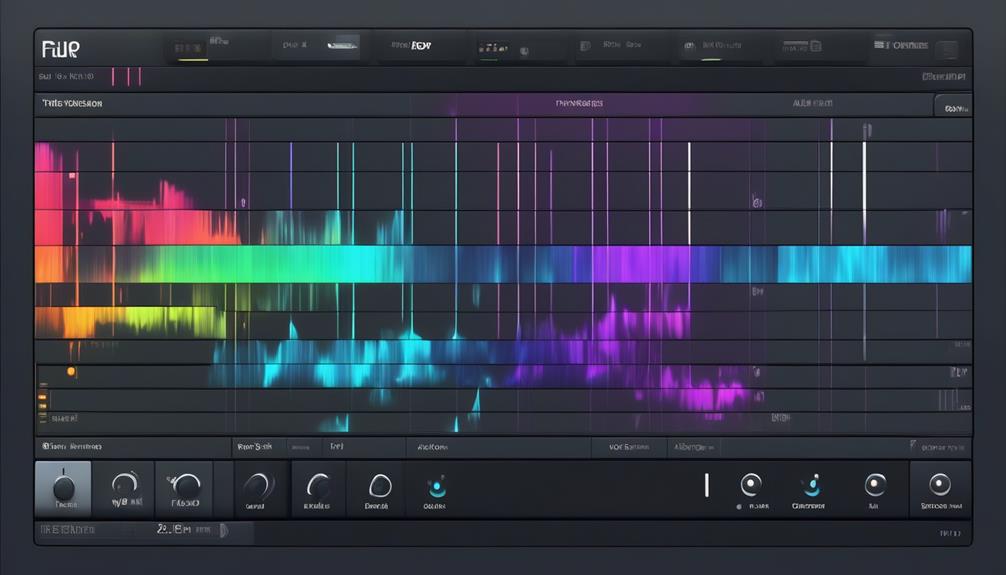No products in the cart.
As you stand at the precipice of the vast electronic landscape, the horizon of music production stretches out before you, filled with the potential for endless creative exploration.
You’ve dipped your toes in the pulsating waters of synthesis and sampled the flavors of diverse genres.
Now, it’s time to arm yourself with the essential principles that will serve as your compass in this sonic wilderness.
From the bedrock of music theory to the architecture of a seamless mix, understanding the basics is your key to constructing tracks that resonate with listeners and stand the test of time.
So, let’s embark on a journey through the fundamental concepts of electronic music production, and uncover the building blocks that will elevate your sound into uncharted territories.
Key Takeaways
- Musical scales and modes are essential for creating melody and harmony in electronic music production.
- Chord progressions play a crucial role in shaping the emotional narrative of a track.
- Understanding rhythm and beat fundamentals, such as tempo variations and drum patterns, is vital for creating impactful tracks.
- Crafting memorable melodies involves creating simple yet emotive tunes, introducing variation, and considering the overall context of the track.
Understanding Musical Scales
To fully grasp the essence of electronic music production, it’s crucial to understand that musical scales form the backbone of melody and harmony creation. These scales aren’t mere sequences of notes; they’re calculated arrangements that define the tonal landscape of your compositions. Each scale possesses a distinctive sonic character, imbuing your tracks with varying emotional qualities. The major scale exudes brightness and joy, while the natural minor scale often conveys a sense of melancholy or introspection.
Delving into modes and their applications further expands your creative palette. Modes are scale variations that start and end on different notes of a scale, each offering a unique flavor. For instance, the Dorian mode carries a jazzy feel, whereas the Phrygian mode introduces an exotic or tense atmosphere.
Moreover, the distances between notes in your scale, known as melodic intervals, significantly impact the mood and movement of your melody. Small intervals can create a sense of closeness and tension, while larger intervals may evoke a feeling of openness or surprise. Understanding these intervals is paramount in crafting melodies that resonate with your intended emotional message.
Exploring Chord Progressions
As you construct the harmonic foundations of your track, it’s crucial to grasp how chord progressions underpin the emotional narrative of your music. Familiarizing yourself with common progression patterns enables you to craft sequences that resonate with your audience, whether you’re evoking joy, suspense, or melancholy.
Mastering modulating chord transitions is key to adding complexity and keeping your listeners engaged throughout the composition.
Building Harmonic Foundations
Chord progressions, the harmonic spine of your compositions, determine the emotional trajectory and structural integrity of your electronic music tracks.
To innovate, you must grasp major and minor chords’ specific intervals, often analyzed with Roman numerals. Delve into advanced harmony with key changes, borrowed chords, and modal interchange, using the circle of fifths to master key relationships.
Your toolkit should include chord inversions, which alter the bass note to add texture, and extended chords that introduce additional tones beyond the seventh, enriching the harmonic palette.
The Unison MIDI Pack can expedite your mastery of these concepts, offering an array of chords and inversions that streamline your workflow and enhance your music theory acumen.
Common Progression Patterns
Delving into common progression patterns, you’ll find that sequences like I V vi IV not only form the backbone of countless hits but also offer a solid starting point for your own creative explorations in electronic music composition.
As you become more comfortable with these foundations, you can start exploring alternative chord progressions to differentiate your sound.
- Experiment with modal interchange to add complexity to your progressions.
- Try retrograde or inversion of familiar patterns for a fresh twist.
- Use pedal points to create tension and release within your progressions.
- Incorporate unique chord voicings to enrich the texture of your electronic compositions.
Understanding and manipulating these progressions with technical precision will help you innovate and keep your music sounding fresh and contemporary.
Modulating Chord Transitions
Exploring modulating chord transitions offers you the tools to infuse your music with dynamic shifts and emotional depth. Employing techniques like pivot chords and secondary dominants allows you to navigate through different harmonic landscapes.
Chord modulation techniques are pivotal when you’re aiming to introduce tension or an unexpected twist in your tracks. Take secondary dominants, for instance; they’re a powerhouse for modulation, momentarily pointing to a chord as if it’s the tonic, before resolving in a way that surprises the listener.
Modulation examples in popular music showcase how effective these transitions can be at evoking strong emotional responses. Delve into modal interchange for a more subtle approach, borrowing chords from parallel modes to create a rich tapestry of sound that keeps your audience engaged and captivated.
Rhythm and Beat Fundamentals
As you venture into rhythm and beat fundamentals, you’ll recognize that tempo variations are essential in setting the track’s pace and mood.
Crafting drum patterns requires a meticulous approach to aligning kick, snare, and hi-hat sequences to form a cohesive groove.
Understanding Tempo Variations
When producing electronic music, varying the tempo can significantly alter the track’s rhythm and energy, influencing the listener’s emotional response. Mastering tempo modulation techniques is vital for crafting a compelling narrative within your music.
Utilizing tempo changes for emotional impact allows you to guide your audience through a spectrum of feelings, from anticipation to euphoria.
Here are some techniques you can use:
- Gradual Accelerando: Slowly increasing tempo to build intensity.
- Ritardando Effects: Decelerating the pace for a dramatic slowdown.
- Beat Dropping: Sudden tempo shifts to surprise and energize the listener.
- Time-Stretching: Manipulating the speed of specific samples without affecting pitch.
Embrace these tools to inject life and sophistication into your compositions, ensuring that they stand out in an ever-evolving electronic music landscape.
Crafting Drum Patterns
To craft compelling drum patterns in electronic music, you’ll need to master the interplay between foundational elements like kick, snare, hi-hat, and various percussion sounds.
Immerse yourself in layering techniques to construct a rich sonic palette, ensuring each percussive hit complements the others.
Focus on the precise alignment of your kick and snare to establish a solid backbone, while experimenting with percussion to inject texture and color.
Employing groove and swing can breathe life into your rhythm, moving it beyond mechanical repetition.
Analyze genre-specific drum patterns to expand your rhythmic lexicon, allowing you to innovate with informed creativity.
Creating Memorable Melodies

Crafting a memorable melody requires a strategic blend of simplicity and complexity, where repetition and variation play key roles in captivating your audience. Creating unique hooks and using melodic motifs are essential in constructing a tune that not only resonates but also stands the test of time. Here’s how you can achieve that:
- Focus on Simplicity: Start with a simple, hummable tune that can serve as the backbone of your track.
- Incorporate Variation: Introduce subtle changes to maintain interest. This could be a slight shift in rhythm or a change in note duration.
- Emotional Connection: Aim to evoke emotion, as melodies that resonate emotionally tend to be more memorable.
- Contrast and Dynamics: Play with contrasting sections and dynamic changes to enhance the impact of your melody.
When you’re working on your melody, think analytically about how it fits within the broader context of your track. Consider the emotional tone you’re aiming for and craft your melody to complement that vibe. Don’t be afraid to innovate with rhythmic structures, intervals, and phrasing to create a melody that’s both unique and relatable. Remember, the goal is to balance predictability with enough surprises to keep your listener engaged and coming back for more.
Harmonizing With Synths
Harmonizing your melodies with synths requires a firm grasp of music theory fundamentals, allowing you to construct chord progressions and textures that enhance the emotional impact of your track. When you’re crafting harmonies, it’s crucial to understand the interplay between scales, chords, and the tonal characteristics of various synth timbres. Utilizing synthesis parameters such as oscillators, filters, and envelopes will enable you to shape harmonically rich synth sounds that complement your melodic structures.
Experimenting with different chord voicings can unveil unique harmonic textures. For instance, spreading out the notes of a chord across octaves or inverting the chord can result in a more dynamic and innovative sound. Synth modulation techniques, such as applying LFOs to pitch or filter cutoff, can add movement to your harmonies, making them breathe and evolve over time.
Creating melodic counterpoints with your synths is a sophisticated strategy to add complexity to your arrangements. This involves constructing secondary melodies that interweave with your main theme, often moving in contrary motion or at intervals that create tension and release.
Moreover, delving into advanced harmony concepts like key changes and modal interchange can elevate your music’s sophistication, providing aural landscapes that captivate and engage your listeners.
Song Structure Essentials


Understanding song structure is vital as it acts as the framework upon which your electronic compositions are built, guiding the flow and dynamics of your musical ideas. Familiarizing yourself with standard frameworks such as intro, verse, riser/build, chorus/drop, and solo can be pivotal. However, innovation within these structures using arranging techniques is what sets your track apart.
- Intro: Set the tone with unique sound design, establishing the mood and hinting at the musical themes.
- Verse: Develop your motifs, balancing repetition and variation to maintain listener interest.
- Riser/Build: Utilize increasing intensity and creating tension, preparing the listener for the climax.
- Chorus/Drop: Deliver a powerful, memorable moment with a punchy mix, where your technical skills shine.
Carefully sculpting each section ensures a cohesive journey through your track. Creating tension and release through dynamic arranging keeps the listener engaged. Each transition is an opportunity to innovate—don’t just rely on risers and drum fills; think about modulating synths or altering the groove. Your goal is to maintain a delicate balance between predictability and surprise, mastering the art of taking your listener on an unforgettable aural journey.
Frequently Asked Questions
How to Make EDM Basics?
To make EDM basics, you’ll dive into sound design, crafting unique textures, and beat making, where you’ll layer rhythms intricately. Innovate with synths and samples for a fresh, technical sound.
Do You Need to Know Music Theory to Make Electronic Music?
You don’t strictly need music theory for electronic music, but it broadens your creative freedom and deepens sound design. It’s a technical edge that can refine and innovate your compositions.
What Is the Basic Music Production Theory?
You’ll delve into chord progressions and beat structure, dissecting how they create a song’s backbone. Your analytical approach will reveal patterns that innovate, pushing boundaries in your music production journey.
How Do I Start Composing Electronic Music?
To start composing electronic music, you’ll need to delve into sound design, crafting unique textures and synths. Master beat programming to establish compelling rhythms that captivate and drive your innovative compositions forward.
Conclusion
You’ve now touched on the core theories behind electronic music production. Remember, scales set the emotional tone, while chord progressions provide a sonic journey.
Your beats are the heartbeat, driving the energy forward. Crafting melodies that linger requires both creativity and technical know-how.
Synths offer a palette for harmonization, and understanding song structure is crucial for dynamic storytelling. Keep experimenting and analyzing to refine your signature sound.
Stay curious and connected with the production community for continuous growth.




